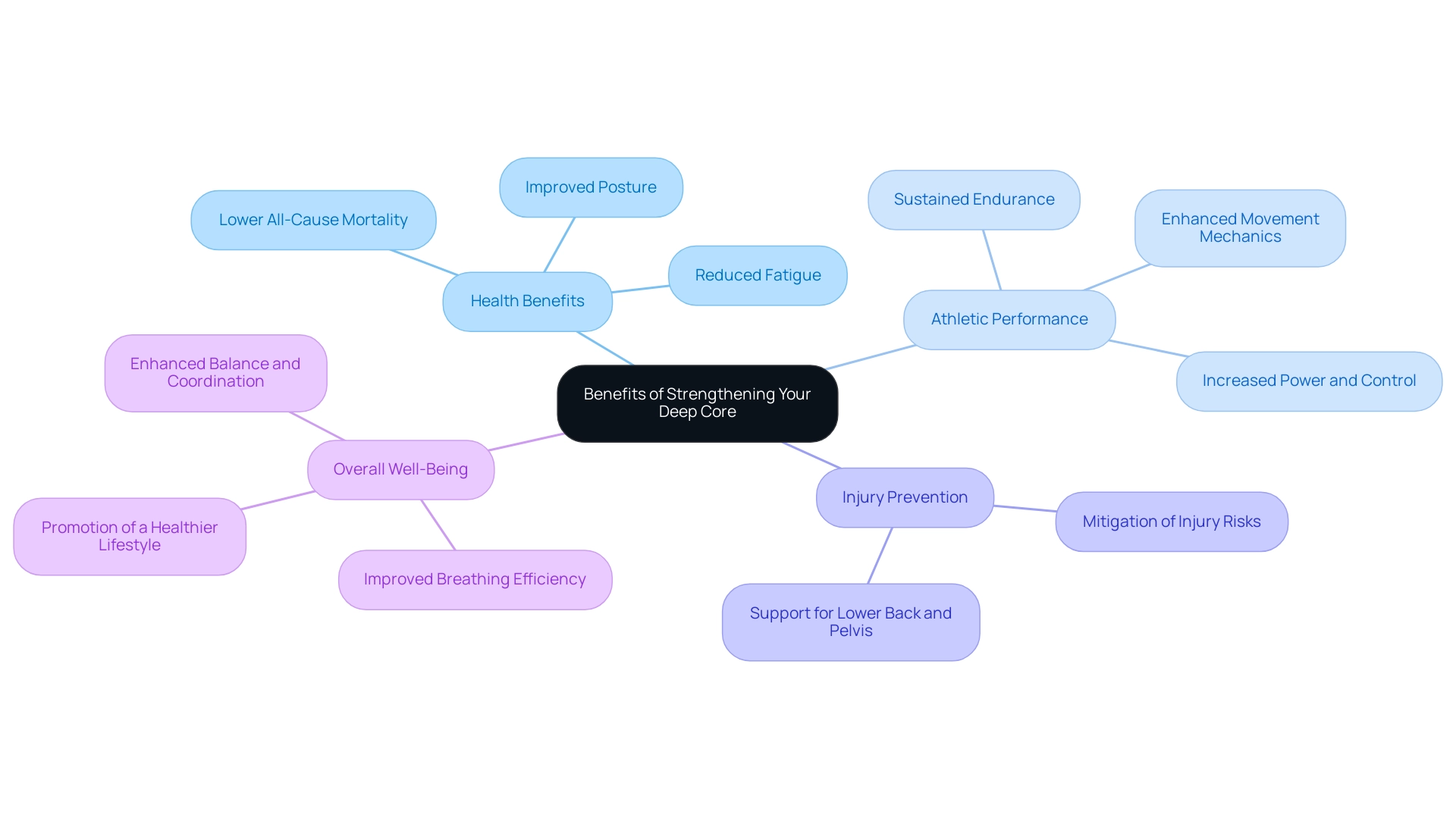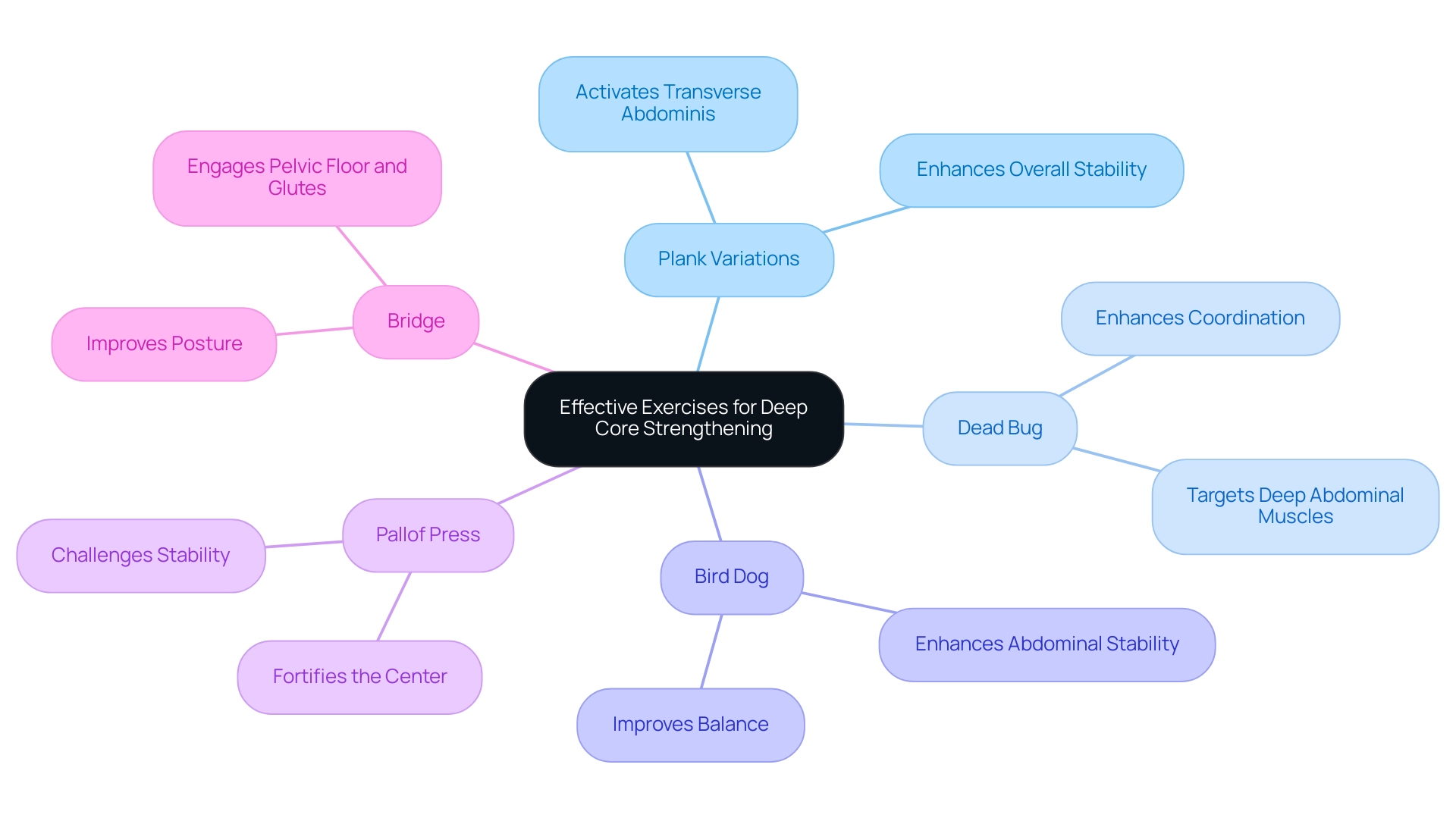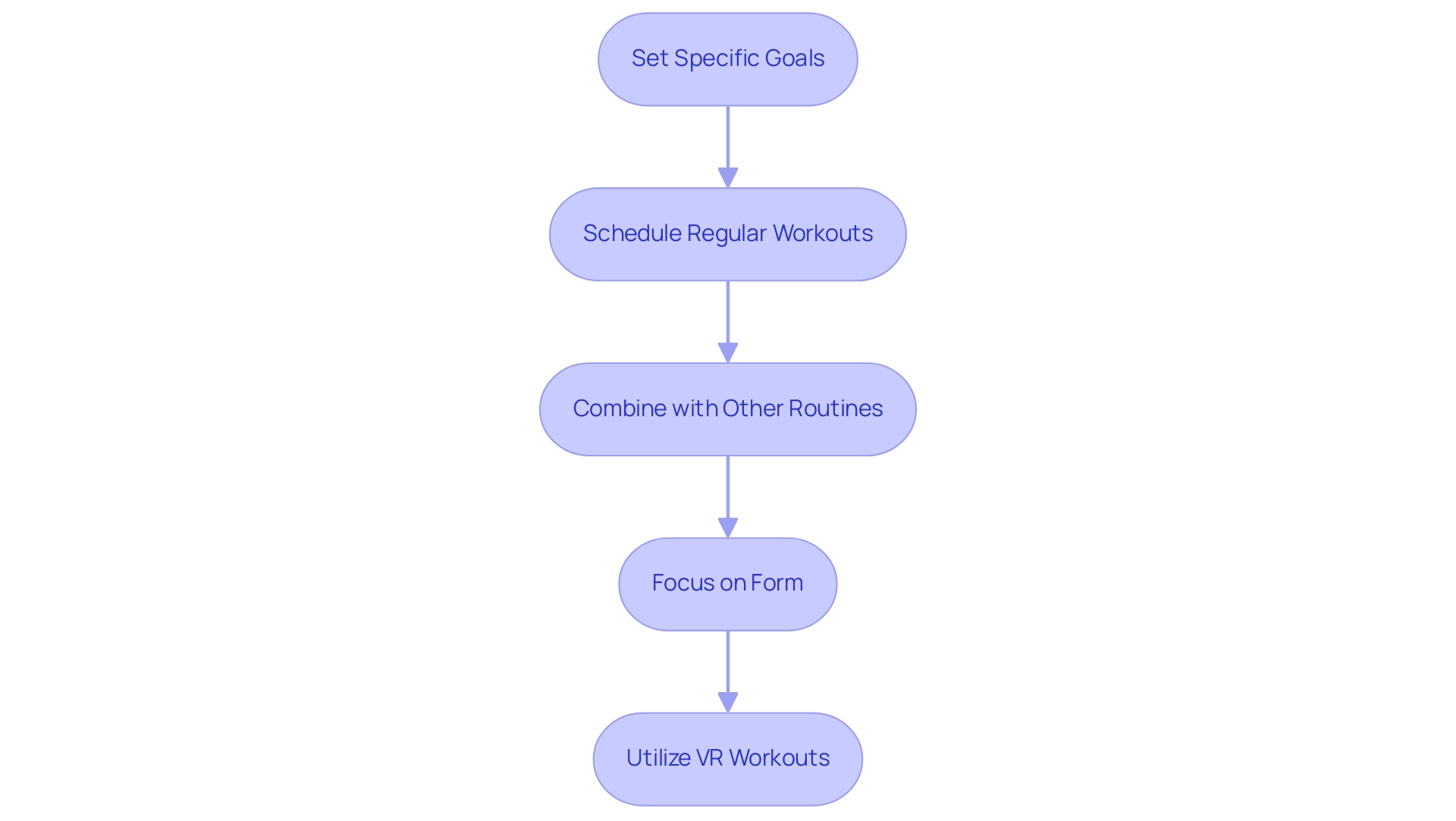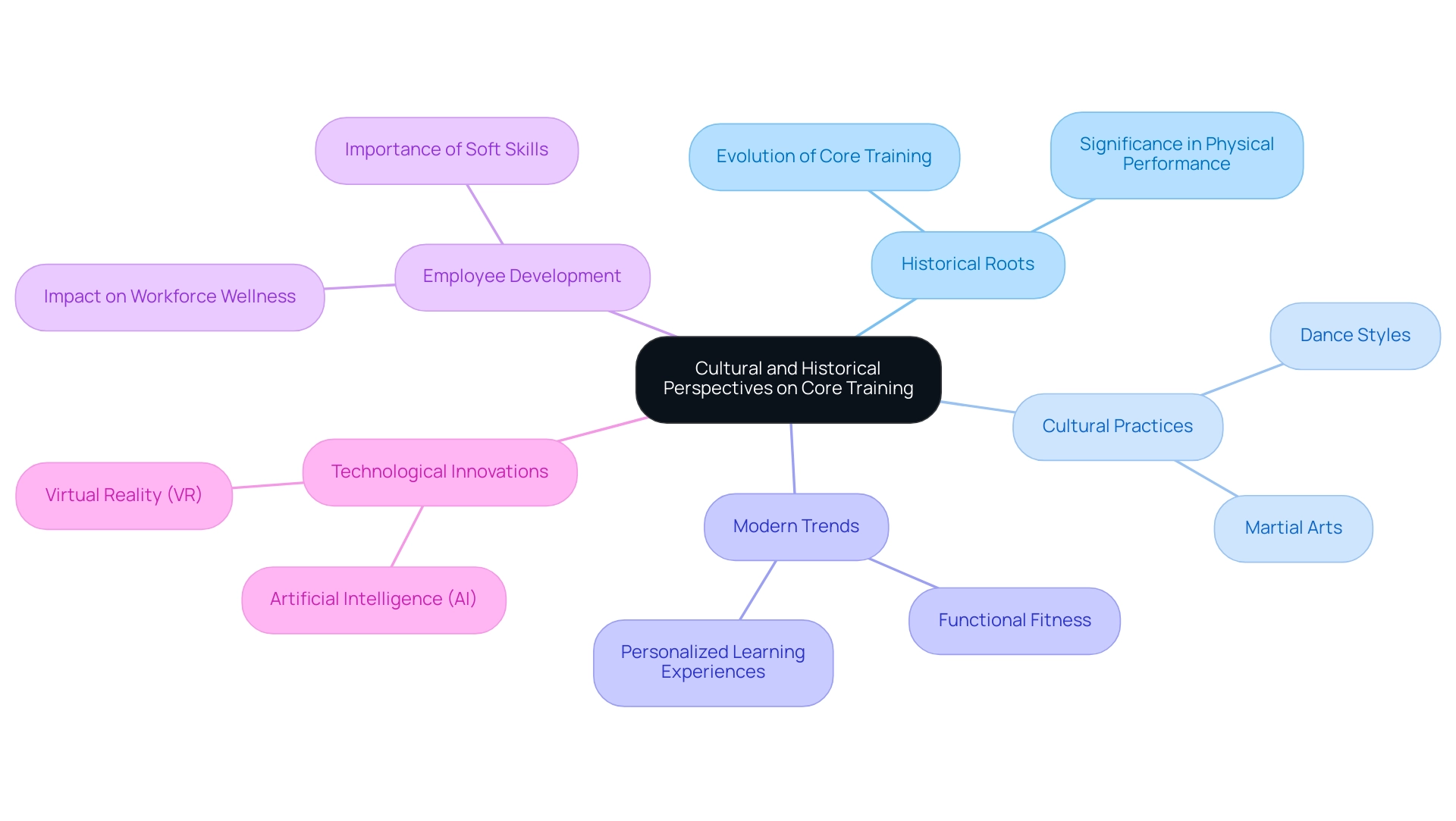Overview
Deep core muscles—including the transverse abdominis, multifidus, diaphragm, and pelvic floor muscles—are essential for stabilizing the spine and pelvis. This stabilization enhances movement efficiency and significantly reduces the risk of injury.
Strengthening these internal muscles not only improves overall physical performance and posture but also plays a critical role in rehabilitation and injury prevention. This underscores their importance for both athletes and general wellness.
Introduction
In the pursuit of optimal health and performance, the importance of deep core muscles is often underestimated. These foundational muscles—transverse abdominis, multifidus, diaphragm, and pelvic floor—are not merely aesthetic; they are crucial for stabilizing the spine, enhancing posture, and preventing injuries.
As contemporary fitness trends evolve, awareness of how a robust deep core contributes to both athletic performance and everyday functionality has grown significantly. The benefits of strengthening these muscles extend from rehabilitation to injury prevention, making them an essential aspect of any fitness regimen.
This article explores the anatomy, benefits, effective exercises, and cultural perspectives surrounding deep core training, underscoring its vital role in fostering resilience and overall wellness.
Defining Deep Core Muscles: Anatomy and Function
Deep abdominal muscles constitute the innermost layer of the abdominal musculature, primarily comprising the transverse abdominis, multifidus, diaphragm, and pelvic floor muscles. These muscles play a crucial role in stabilizing the spine and pelvis, providing essential support during movement, and ensuring proper posture. Unlike the more superficial muscles often emphasized in traditional workouts, internal stabilizing muscles are vital for functional strength and injury prevention.
Research indicates that a robust internal foundation is essential for maintaining stability and balance, particularly during dynamic activities. For instance, fundamental strength across various planes, including trunk lateral flexion, significantly enhances performance in exercises such as squats and deadlifts, especially under unstable conditions. This underscores the necessity of incorporating comprehensive foundational training into fitness routines.
Statistics reveal normative values for endurance in stability activities, with men averaging 95 seconds and women 74 seconds in side plank and bridge holds. Such benchmarks highlight the importance of developing these muscles not only for athletic performance but also for daily activities. Healthcare experts advocate for regular exercise as a preventive measure against lower back pain, emphasizing that strengthening internal muscles can mitigate injury risks.
As noted by Studnicka K., "there is no role for surgical intervention in mechanical low back pain," further reinforcing the need for preventive strategies.
Furthermore, recent studies emphasize the significance of fundamental muscles in enhancing posture and stability, which are critical for overall wellness. A well-functioning core supports the body during various movements, reducing injury likelihood and enhancing functional strength. Case studies have demonstrated that incorporating clinical tests for lumbar instability can improve the identification of mechanical back pain, thereby facilitating more effective treatment strategies.
In summary, prioritizing intense central muscle training is essential for cultivating a resilient and healthy workforce. By investing in programs that enhance fundamental strength, organizations can promote employee wellness, reduce injury rates, and ultimately improve productivity.

The Benefits of Strengthening Your Deep Core
Enhancing inner muscles offers numerous advantages that extend beyond mere appearance, significantly impacting overall health and athletic performance. A strong internal structure is essential for stabilizing the spine, which in turn improves movement mechanics and efficiency during physical activities. This stability is particularly crucial for athletes, enabling more powerful and controlled movements, ultimately leading to enhanced performance on the field or court.
Moreover, a robust inner structure is vital for preventing injuries. By supporting the lower back and pelvis—areas often vulnerable to strain during intense physical exertion—these muscles help mitigate injury risks. Regular engagement of deep core muscles not only strengthens these critical areas but also enhances balance and coordination, which are essential for both daily activities and athletic pursuits.
Research indicates that individuals with well-developed central strength experience improved posture and reduced fatigue, contributing to overall well-being. In fact, studies have shown that resistance training, which includes strengthening exercises, can significantly lower all-cause mortality rates. This underscores the importance of maintaining a strong foundation as part of a comprehensive fitness program, particularly in a corporate wellness context where employee health is paramount.
Furthermore, specialists emphasize the significance of deep core strength and its relationship to athletic performance. Trainers assert that a strong center is foundational for executing complex movements and sustaining endurance throughout physical activities. As athletes engage in exercises that prioritize thorough abdominal activation, they often report enhanced breathing efficiency, as the diaphragm's function is closely linked to abdominal stability.
Nick Rizzo, Fitness Research Director, observes, "That's why the advantages of resistance exercise for seniors and older adults are so significant," highlighting the extensive relevance of foundational strength across demographics.
Incorporating activities such as the front plank on a Swiss ball with hip extension can maximize multifidus activation, further amplifying the benefits of deep abdominal training. This specific exercise not only illustrates the practical application of fundamental strength but also aligns with Foresight Health Coaching's corporate partnership objectives of enhancing employee performance and fostering a cohesive team culture. By prioritizing fundamental strength, individuals not only improve their athletic capabilities but also promote a healthier lifestyle, which is crucial for long-term success in both personal and professional realms.

Effective Exercises for Deep Core Strengthening
Efficient workouts for fortifying the deep center are crucial for improving overall physical performance and stability. Key exercises include:
- Plank Variations: Engaging in various plank positions is highly effective for activating the transverse abdominis and multifidus muscles. Research indicates that these variations not only improve central strength but also enhance overall stability, making them a cornerstone of any central training regimen.
- Dead Bug: This activity enhances coordination and stability while specifically targeting the deep abdominal muscles. It is especially advantageous for enhancing central engagement during dynamic movements, which is essential for athletic performance.
- Bird Dog: A functional movement that enhances balance and abdominal stability, the Bird Dog activity is excellent for developing the connection between the upper and lower body, fostering better overall body mechanics.
- Pallof Press: This anti-rotational activity challenges stability while fortifying the center. It is especially effective for enhancing stability and resilience against rotational forces, which is essential for many sports and daily activities.
- Bridge: By engaging the pelvic floor and glutes, the Bridge movement also targets the deep center. This activity not only fortifies the center of the body but also aids in improved posture and decreased likelihood of back discomfort.
Integrating these activities into a consistent fitness regimen can greatly improve central strength and overall physical capability. Specialists suggest engaging in intensive abdominal workouts at least three to four times weekly, ideally combined with a nutritious diet and consistent cardiovascular activities for the best outcomes. Christine VanDoren, PT, recommends, 'Aim to perform intensive abdominal workouts at least three to four times a week and combine them with a nutritious diet and consistent cardio for best outcomes.'
A case study titled 'Benefits of Deep Abdominal Exercises' explains what is deep core, highlighting that targeting the muscles deep within the abdomen leads to improved strength, better posture, and enhanced overall performance in physical activities. Furthermore, studies indicate that employees who engage in physical activity for at least 30 minutes three times per week are more likely to report feeling motivated at work. By concentrating on these beneficial activities, individuals can develop a stronger, more resilient center, ultimately contributing to a healthier and more efficient body movement.

Deep Core Training for Rehabilitation and Injury Prevention
Intensive training plays a pivotal role in rehabilitation and injury prevention, particularly for individuals recovering from back injuries or surgeries. Strengthening foundational muscles is essential for restoring stability and function, facilitating a safer return to physical activities. Physical therapists frequently incorporate intense abdominal exercises into rehabilitation programs, as these activities enhance spinal stability and alleviate discomfort.
Research indicates that a robust inner structure significantly contributes to injury prevention by promoting proper alignment and mechanics during movement. This is particularly critical for athletes and active individuals; maintaining optimal strength in the core can enhance performance while reducing the likelihood of injuries. For instance, studies have shown that individuals engaging in intensive abdominal strengthening workouts at least two to three times a week experience improved muscle development, better posture, and reduced back discomfort—benefits that support overall health and wellness.
Moreover, extensive strengthening of the abdomen can mitigate the risk of diastasis recti during pregnancy, underscoring its relevance for a broader audience.
Furthermore, expert insights underscore the importance of consistency in intensive training. Christine VanDoren, PT, recommends performing these exercises three to four times weekly, complemented by a balanced diet and regular cardiovascular activity for optimal results. By prioritizing deep central strength, individuals not only enhance their resilience against future injuries but also improve their overall physical performance, making this a crucial component of any fitness regimen.
In addition, integrating fundamental workouts into busy schedules is vital for sustaining overall wellness and vitality. The case study titled 'Guidelines for Essential Activity Frequency' supports the recommendation of engaging in strengthening activities at least two to three times a week, allowing for recovery days between sessions.

Incorporating Deep Core Exercises into Your Fitness Routine
Integrating profound central workouts into your fitness regimen can be successfully accomplished through various tactical methods:
- Set Specific Goals: Clearly define your objectives for central conditioning, whether it’s improving stability, preventing injuries, or enhancing athletic performance. As fitness author Kate Neudecker highlights, setting quantifiable objectives can greatly enhance enthusiasm and commitment to the program.
- Schedule Regular Workouts: Aim to incorporate intensive abdominal workouts into your routine at least two to three times a week. Consistency is key; consider scheduling these workouts alongside your existing fitness sessions to ensure they become a regular part of your regimen. Studies show that people who integrate fundamental workouts into their fitness regimens report enhanced performance and diminished tiredness.
- Combine with Other Routines: Maximize the advantages of deep abdominal training by understanding what is deep core and pairing these activities with strength training or cardiovascular routines. For example, the Cable Woodchop activity includes rotational movements to enhance the midsection while standing. This comprehensive method not only boosts fundamental strength but also enhances overall fitness and stamina.
- Focus on Form: Prioritize proper technique during workouts to ensure effectiveness and minimize the risk of injury. Engaging a qualified fitness professional is increasingly important, as there is a growing need for Registered Exercise Professionals to ensure high standards in fitness programming. They can offer valuable insights on form and technique, further improving the workout experience.
Furthermore, utilizing VR workouts can lessen the perception of effort, making physical activity feel more enjoyable and encouraging more employees to engage in essential development. By consistently incorporating these activities, individuals can develop a strong and resilient foundation that supports their overall health and performance. Additionally, structured programs, as highlighted in case studies on coaching platforms for fitness professionals, can improve client engagement and outcomes in fitness routines.

Cultural and Historical Perspectives on Core Training
Over the years, core training has undergone a remarkable transformation, influenced by diverse cultural practices and evolving fitness trends, leading many to inquire about what constitutes deep core. Historically, fundamental workouts were frequently simplistic, primarily focusing on the abdominal muscles through basic movements. However, numerous cultures have long acknowledged the significance of essential strength as a fundamental aspect of physical performance.
For instance, martial arts and various dance styles have traditionally underscored central stability and strength, deeming it crucial for balance, agility, and power.
In 2025, the resurgence of functional fitness has further emphasized central conditioning, shifting the focus towards exercises that mimic real-life movements. This evolution reflects a broader understanding of how fundamental strength contributes not only to athletic performance but also to everyday activities. Recent statistics indicate that individuals participating in foundational exercises report improved overall wellness, with enhanced physical capabilities and decreased injury rates.
Furthermore, investing in employee development and education results in a more skilled and informed workforce, highlighting the importance of essential practices in corporate wellness programs.
Expert perspectives underscore the cultural significance of fundamental practices. Fitness historians observe that central strength has been revered across civilizations, often linked to the ability to perform complex movements and maintain physical resilience. As fundamental education continues to evolve, it is essential to appreciate its historical roots and cultural influences, enriching our understanding of its role in promoting wellness across various populations.
Moreover, the priority of developing soft skills for company executives and learning professionals is increasingly recognized, and essential education can play a vital role in this development. Case studies illustrate that incorporating essential exercises into wellness programs can yield notable enhancements in employee health and productivity. Organizations that emphasize fundamental strength development not only promote a healthier workforce but also nurture a culture of well-being that resonates throughout their teams.
As Steve Fiehl, chief innovation officer, observes, the ability to offer personalized learning experiences is being disrupted by 'mass personalization,' applicable to fundamental development programs. Additionally, emerging technologies like virtual reality (VR) and artificial intelligence (AI) are being explored to enhance personalization and effectiveness, providing immersive learning experiences that improve skill development and engagement among employees. By acknowledging the historical and cultural aspects of fundamental development, along with the innovative methods available, we can better appreciate its essential contribution to holistic health and performance.
Foresight Health Coaching's partnership offers organizations the opportunity to build a healthier, happier, and more cohesive team culture through core training initiatives.

Conclusion
Strengthening deep core muscles is not merely beneficial; it is essential for optimal health, athletic performance, and injury prevention. These foundational muscles play a crucial role in stabilizing the spine, enhancing posture, and supporting efficient movement. By incorporating deep core training into fitness routines, individuals can significantly improve their physical capabilities while simultaneously building resilience against injuries, particularly in vulnerable areas such as the lower back and pelvis.
The advantages of a strong deep core extend well beyond aesthetics. They encompass better balance, coordination, and overall well-being. Effective exercises, including planks, dead bugs, and bridges, can markedly enhance core strength, leading to improved performance in both athletic and daily activities. Furthermore, a consistent approach to core training is vital for rehabilitation, facilitating a safe return to physical activities while minimizing future injury risks.
As fitness trends increasingly emphasize functional movements, integrating deep core exercises not only supports individual health but also fosters a culture of wellness within organizations. By prioritizing core strength, organizations can boost employee productivity, reduce injury rates, and promote a healthier workforce.
In conclusion, the importance of deep core muscles cannot be overstated. Investing in their strength is a proactive strategy for achieving optimal health and athletic performance, ensuring long-term well-being. Embracing a comprehensive core training regimen leads to a stronger, more resilient body, capable of thriving in both personal and professional settings.




